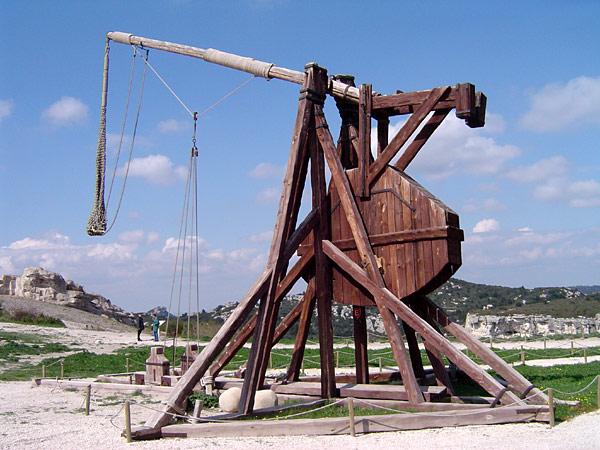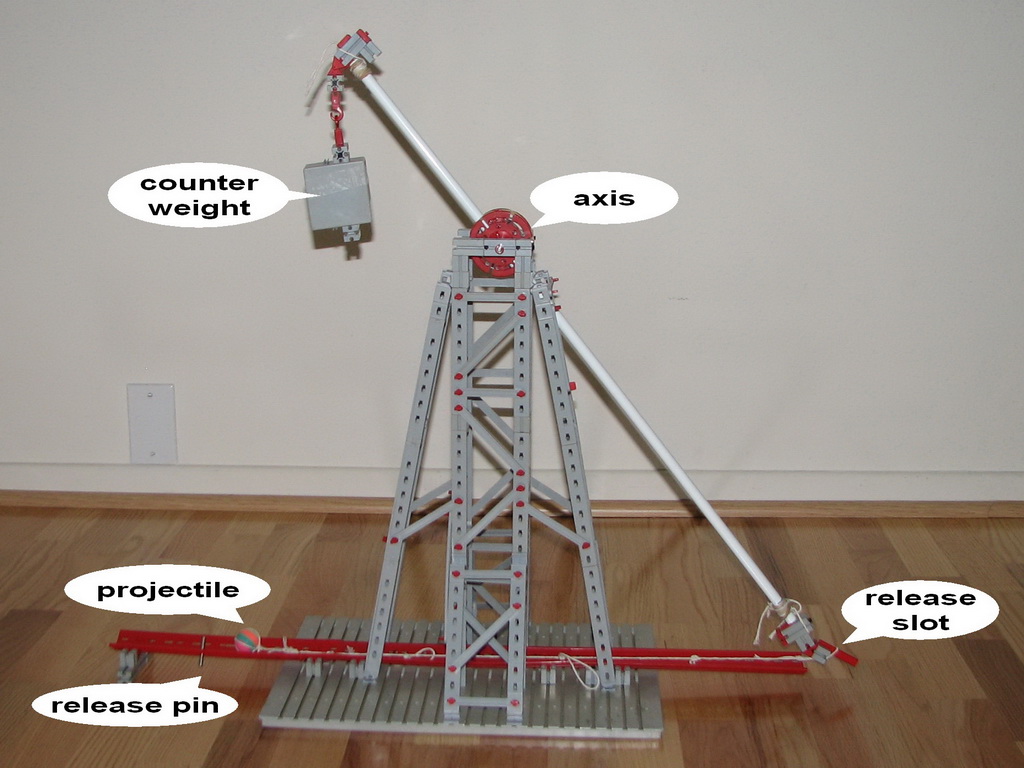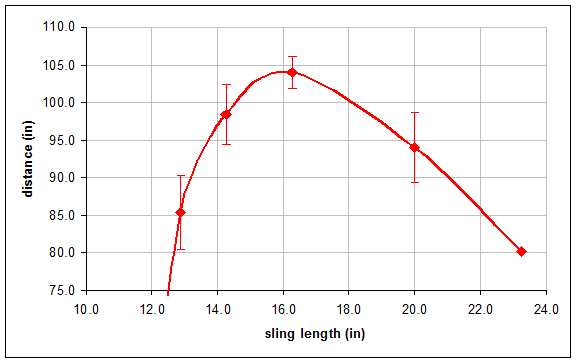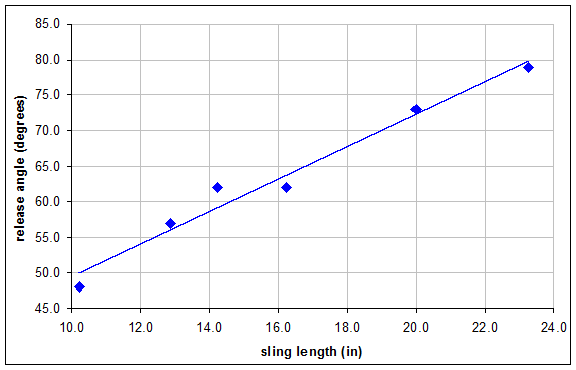
Illustration
1: Trebuchet at Château des Baux, France
3 – 2 – 1 Fire!!
by Dominic Moser.
When I use and trebuchet, what length of string that holds the projectile will make the projectile fly farthest?
I think if I make the projectile longer, the projectile will fly a longer distance than with a shorter string.

Illustration
1: Trebuchet at Château des Baux, France
To fire a trebuchet, the engine master ordered his crew to tug on ropes attached to blocks and tackles or heavy winches. “Heave!” cried the captain. “Heave again!” The heavy weight would rapidly gain elevation, and as it did so, the throwing end will lower closer and closer to the ground. When the counter was at full height, a stout pin was inserted into the framework to keep the counterweight in place.
A sling was then attached to the throwing end and a stone projectile placed within. When all was ready, the commander would get a sledge hammer and knock loose the holding pin. Down fell the weighted bucket, and up went the throwing arm, dragging the sling. The sling would snap forward, and at just the right angle, the projectile would leap free, flying far and true against the castle wall. Crash!
Reference: the art of the catapult by William Gurstelle.
Fischertechnik
25 in long string
206 g lead for weight
Bouncy ball, one inch diameter
Measuring tape
Digital camera
I have a built a Trebuchet from Fischertechnik (see picture). I fixed one end of the string to a projectile. At the other end I formed a loop that easily fits over the release slot of the throwing arm.

For each experiment, I lifted the weight, attached the loop of the sling to the release slot, and fired the Trebuchet. I repeated each experiment five times to reduce the error of the results. I was always careful that nobody was nearby and could get hurt from the flying projectile. I repeated the experiment for different lengths of the string. I have also used a digital camera to measure and study the release angle.
I researched how to build a Trebuchet in books and on web-sites and built one out of Fischertechnik. Before I started my experiment, I decided to keep the pole length, counter weight, and the release angle the same and vary the length of the string holding the sling.
For each of the six lengths of the string that holds the projectile, I fired 5 times to reduce the error. For these lengths I calculated the average and the amount of error. I also measured where the release point was. The release point is the angle of the pole to the horizontal line.

Illustration
2: Flying distance of the projectile for different sling lengths.

Illustration
3: Release angle for different sling lengths.
The results are summarized below. For example, for a 16.3 in long string the projectile flew 104 in. The release angle was 62 degrees. I found that the maximum flying distance of the projectile was 104 in with a 16.3 in long string.
|
sling length (in) |
distance (in) |
error (in) |
release angle (degrees) |
|
10.3 |
0.0 |
0.0 |
48 |
|
12.9 |
85.4 |
2.2 |
57 |
|
14.3 |
98.4 |
5.0 |
62 |
|
16.3 |
104.0 |
3.9 |
62 |
|
20.0 |
94.0 |
2.2 |
73 |
|
23.3 |
80.2 |
4.6 |
79 |
The physics of a Trebuchet is fairly complicated. When the Trebuchet is put into firing position, the weight is pulled up against gravity. The weight now has gravitational potential energy. On the other side of the axis there is a release slot, where you attach the string holding the projectile. The projectile is held into position by a release pin. When you pull the pin, the weight falls down and pulls the projectile forward. The gravitational potential energy is converted to motion or kinetic energy. The projectile releases itself when it has enough speed and force to pull the string out of the release slot. Now the weight has “0” gravitational potential energy.
I observed that when the string is too short the projectile won’t fly far. If I make the string longer the projectile will go farther. The distance was 104 in for a string length of 16.3 in. When I made the string even longer, the projectile flew a shorter distance than before. These data told me that there is a maximum distance that the projectile can fly using a string length of 16.3 in.
These data show that if the string is too long, the projectile won’t go into an arc and fly over the axis. Instead, almost all the energy is being used to get the ball moving and into the air. By the time the ball is in the air, the counter weight is almost at its lowest point. In this situation the projectile is released too late, i.e. the release angle is too large. If the string is too short, the projectile will fly of the throwing arm too early. The pin releases the ball into the air directly after the counter weight starts going down. The ball does not have time to go in an arc gather momentum too early and even flies of backwards. Here the projectile is released too early and the release angle is too small.
The projectile flew farthest for a string length of 16.3 in, the Trebuchet swings correctly and the ball is released at a medium angle. The release angle is optimal as it provides enough forward momentum to the projectile and releases it with a slightly upward trajectory.
My hypothesis was false.
In my project, I have changed the string length of a Trebuchet for a constant weight and pole length. I learned that when I use a really long string like 20 in, the projectile won’t fly a s far as with a 16.3 in long string. If the string is too short, such as a 10 in long string, the projectile will fly off backwards. If you use a 16.3 in long string the projectile will fly the farthest of the all.
In my research I learned that the optimal string depends on the amount of weight and the pole length.